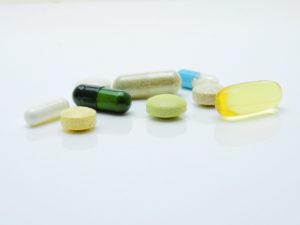Every time we hit the grocery store, we are surrounded and enticed by food myths. The food industry knows what we, as parents, want. We want the safest and healthiest food for our kids. Unfortunately, many times, companies are not above using our concerns and fears to improve profits. It is often confusing to determine which of the claims on food labels are meaningful, or even accurate, and which are not.
I work in a department with food and agricultural scientists, so food myths are common topics of conversation around here. But the other day, as I was walking through the grocery store, I really started to look around and noticed how many things were labeled in a way to make us think that they are the healthier alternatives. These alternatives often provided little to no benefit, and at times, could even be worse for you!
Here are some of the biggest myths that the food industry is selling to you. Most of them are designed to make you spend more money in the name of healthy eating.
Myth #1: Organic foods are healthier and pesticide-free
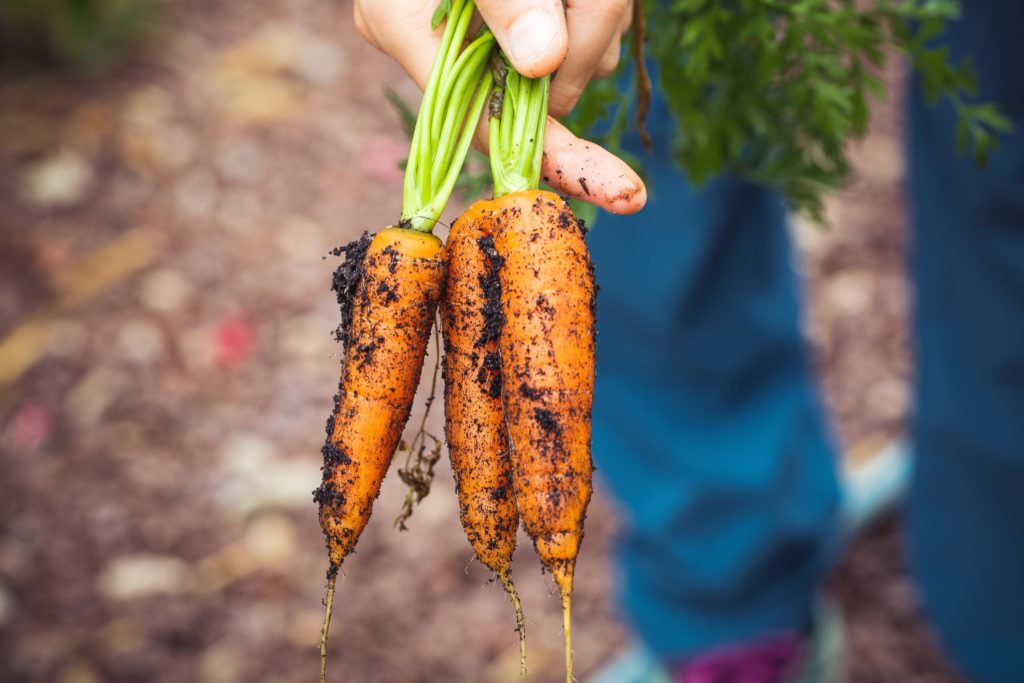
Most people who choose organic food options do so because organic food is touted as healthier and pesticide free. It’s true that organic operations aren’t allowed to use most synthetic products on their crops and in their feed. This includes many of the pesticides that are currently used when growing conventional foods. But this still doesn’t mean that organic foods, themselves, are pesticide-free. Here are the facts:
- In an analysis of over 200 studies testing for differences in nutrient and pesticide content between organic and conventional foods, researchers found that organic products did not have higher nutrient content, as is often touted.
- Many organic foods do still have measurable pesticide residues, often from neighboring non-organic operations.
- While the amount of pesticide residues were lower on organic foods, neither organic nor conventional foods had pesticide amounts that were above the upper limits posed by the USDA. So, while you may be exposed to slightly lower levels of pesticides in organic foods, the degree of difference is not likely to be enough to actually impact your health.
Take home: Organic products are not much healthier, and do not provide enough of a health benefit to be worth the higher price tag.
Myth #2: Gluten-free foods are healthier
Gluten-free foods are the new craze. Even kids’ juices are given the label, just to make consumers think the juices are extra-healthy. In reality, gluten is not harmful, or unhealthy, unless you have celiac disease. Celiac disease is an autoimmune disease that causes intestinal damage when gluten is ingested. According to the Celiac Disease Foundation, only 1% of Americans have it. Here are the myths and the facts:
- Gluten is unhealthy: Nope, it is simply a protein that is found in some of the plants we eat.
- Gluten-free diets are beneficial to everyone: Nope, this is similar to saying that everyone should avoid eggs because some have allergies to them.
- A gluten-free diet will help you to lose weight: Nope, it might actually lead to weight gain because many gluten-free products add fats and sugars to make up for the lack of gluten.
- Gluten causes cancer: Nope, there is no evidence that gluten causes cancer. Humans have been eating foods with gluten for tens of thousands of years.
Take Home: Unless you have a gluten sensitivity, don’t shell out the extra dollars for a food just because it’s labeled ‘Gluten-free’.
Myth #3: GMO-free foods are safer
Genetically modified organisms (GMOs) are plants or animals that have been genetically engineered to improve their survivability and yields. While there are currently no genetically engineered animals on the market yet, we already consume and use products that contain genetically engineered plants. Corn, soybeans, and cotton are three examples.
It is understandable why GMO foods seem so scary. The idea of meddling with something’s DNA brings up visions of mutant spiders and alien invaders from comic books. But really, there’s nothing alien about it. Here are the facts:
- The genes that are being spliced into GMO plants may be harmful to insect pests, but are harmless to humans.
- The inserted DNA from the plants cannot jump into humans and cannot cause cancer.
- Extensive studies demonstrate that GMOs currently on the market do not trigger allergic reactions.
- All products containing GMOs must undergo rigorous testing (that takes an average of 13 years!) by the Food and Drug Administration (FDA) before they are allowed to go to market.
Even better, genetic engineering of many plants like corn, cotton, and soybeans, reduces the need for pesticides, because these new plants are already resistant to the pests that attack them. So, products containing GMOs often have lower levels of pesticide residues.
For more detailed information about the safety of GMOs, check out my recent post devoted entirely to this subject.
Take-home: Products labeled “No GMOs” are not healthier than their counterparts that have GMOs in them, so they’re not worth spending extra money for.
Myth #4: Brown eggs are healthier than white eggs
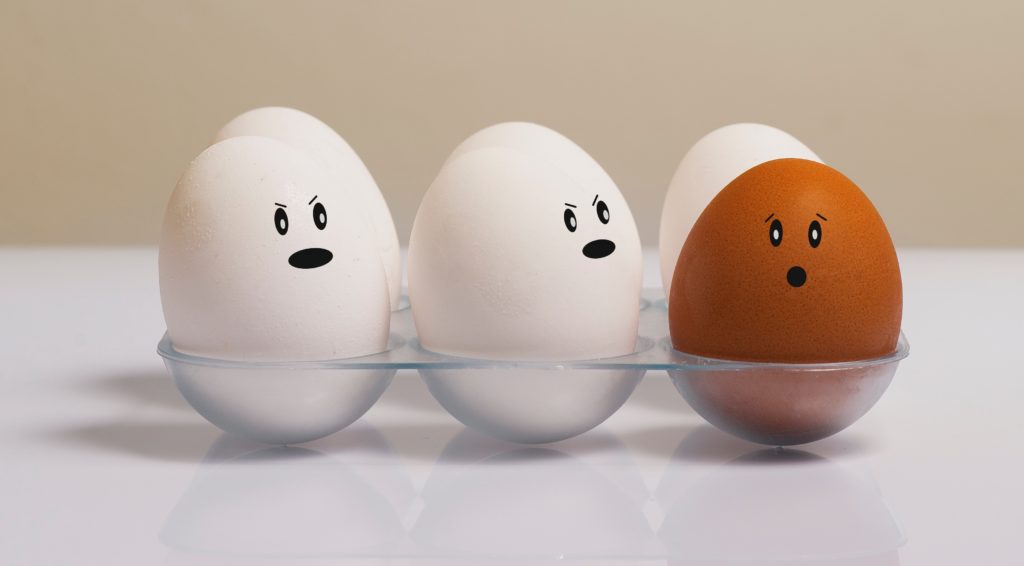
When we shop for eggs these days, we are faced with a very colorful range of choices, some of which cost up to $5 a dozen! One reason you may see an upcharge is simply because the eggs are brown. This cost difference is not because brown eggs are better, but because the strain of hens that produce the brown eggs are larger and cost more to raise. Many tests have shown that there is no nutritional benefit to eating brown eggs over white ones.

Myth #5: Cage free eggs are healthier and more humane than conventional eggs
While we’re on the subject of eggs, there are also other egg options in the same supermarket section. There is a worldwide movement to reduce the number of laying hens kept in cages, and in some states, legislation is even being passed that requires egg producers to keep hens out of cages.
As a result, some of the eggs you’ll see are labeled ‘cage free’ and ‘free-range’. These words bring about thoughts of happy hens frolicking in the grass, but real cage-free housing is not exactly as you might imagine. Here is a picture of a cage-free aviary:
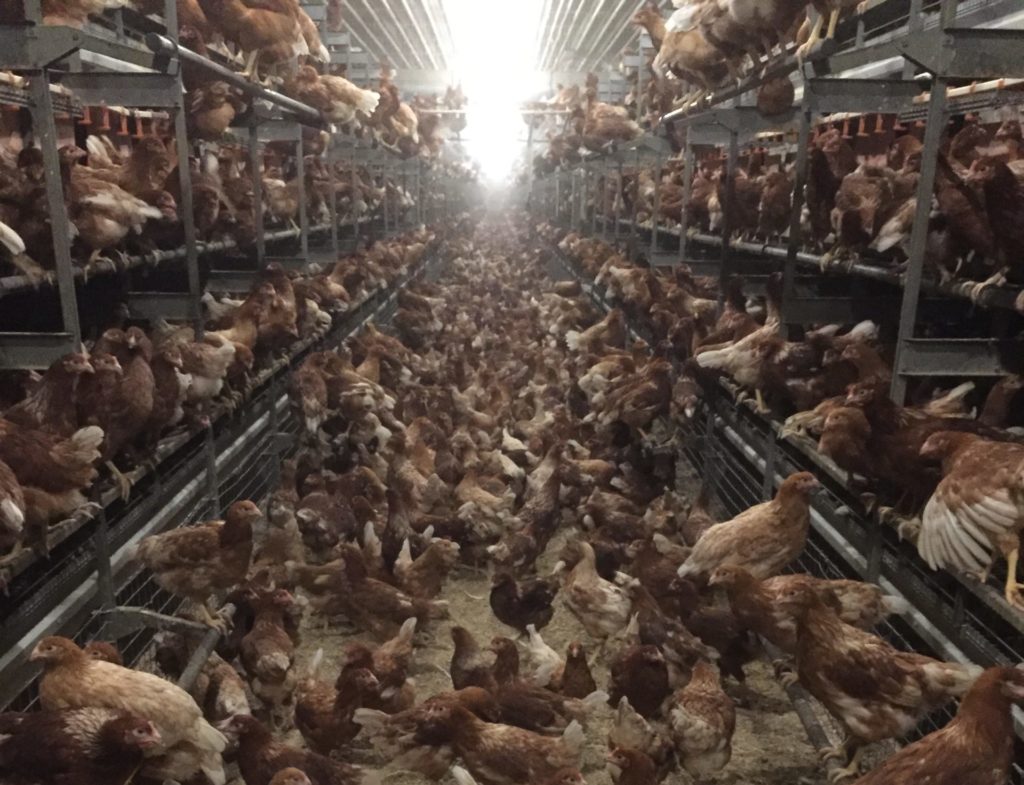
Hens in these environments must constantly fight for their social status, they are often exposed to more hens that could carry more diseases, and they may, at times, even have less room than those kept in cages. Free-range hens are usually housed in similar environments, but with a small door to a crowded outdoor porch or patch of grass. The nutritional contents of their eggs do not differ from conventional eggs.
Take-home: Eggs from cage-free and free-range hens are not better, nutritionally.
If you want some real bang for your extra buck, go for pasture-raised eggs. These hens are raised outside with ample space to roam, and their eggs contain more vitamin E and omega-3 fatty acids, which makes them the healthiest options. You might also try eggs enriched with omega-3 fatty acids as another option as well.
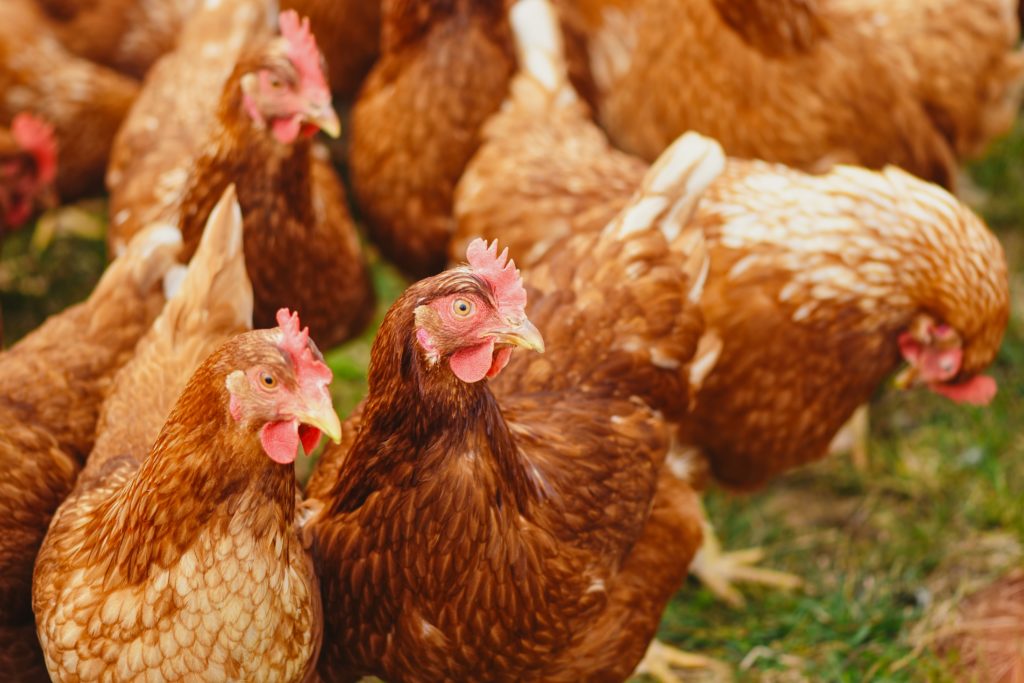
Myth #6: Foods labeled ‘Antibiotic free’ are safest
Historically, livestock were provided regimens of low-level antibiotics in their feed to prevent them from getting sick while being raised. As an added benefit, these antibiotics often reduced the risk that these animals would contract a bacterial infection that they could then pass to people who eat them. But there were concerns that this practice could trigger antibiotic resistance in some of those bacteria. So here are the facts:
- The FDA ruled that antibiotics can now only be used to treat existing infections in livestock and control infection outbreaks in groups where sickness has been detected.
- If the animals were, at some point, treated with antibiotics, producers must insure that those antibiotics clear the body well before the meat is sold to you.
- This means that all meat you buy is antibiotic-free.
Take home: You will never encounter a product with antibiotics in it, and livestock operations are no longer allowed to use antibiotics frivolously, so don’t fall for that marketing and pay more.
Myth #7: Poultry and Pork labeled “No added hormones” are safest
Another mom scientist blog (Sci Moms) did an awesome job addressing this one in detail, but I’ll summarize it because it’s just not fair that some products charge you more for a ‘No Added Hormones’ label. The ones that are most egregious are the packages of poultry and pork with this label plastered on them.
Back in the 1950’s, the FDA banned the use of hormones in chickens and in pork. Yet, some companies began putting that label on their packages to prey on the fears of consumers.
Because this was viewed as dishonesty, the FDA began requiring companies that use that label to also place a statement that says “Federal regulations prohibit the use of hormones” somewhere on their packaging. However, companies often make this label super small so it almost takes a magnifying glass to see it.

Take-home: Don’t let those packages fool you into paying more! None of the poultry or pork products on the shelf have added hormones.
Myth #8: Multigrain bread and wheat bread are healthy
We’ve all heard that consuming bread made with whole grains is healthier than consuming processed white bread. This is because the two types of bread are metabolized differently. Breads with whole grains are digested more slowly, preventing blood sugar spikes after they’re eaten. Yet some brands have designed their product labels so that these products may fool you into thinking that they’re made with whole grains when they actually aren’t.
I looked at food labels of all multigrain and wheat breads I could find in the supermarket. The Nature’s Own brand breads were particularly misleading. Their multigrain, honey wheat, and white wheat breads are made with enriched flour, not whole wheat. They are unlikely to be much healthier than plain white bread.
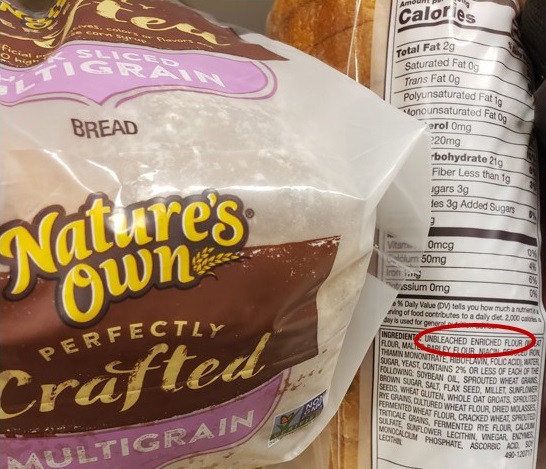
Take-home: Before purchasing breads with one of these labels, check the ingredients first. You’re looking for ingredients that say whole oats, whole–wheat flour, whole–grain corn, whole–grain brown rice, or whole rye.
Myth #9: Bottled water is safer than tap water
In an age when we’re all concerned about what’s in our water, those bottles of water sitting in the supermarket seem like they’d be a lot safer, right? Well, for several reasons, they’re probably not. In the US, our drinking water is continuously monitored according to federal standards, and treated to ensure that contaminants, bacteria, and fungi stay below harmful limits. The quality of bottled water is monitored less often, if at all. Here are the facts:
- Researchers tested 6 different brands of natural spring water sold in California, and showed that not only did all of them contain 14 heavy metals, but in all 6 brands, arsenic was present in levels that exceeded public health goals set for the state of California.
- In addition, multiple sources found bacteria, some of which are pathogenic, in bottled water as well.
- Many of the bottled water brands on the market are nothing more than glorified tap water, marked up in price a few thousand times.
When you’re at the supermarket, you’ll see many different types of bottled waters. The FDA has published standards that go along with those different labels you see on bottled water in the store:
Drinking water – this is nothing more than tap water packaged in a sterile container with no additives.
Filtered water – this water is generally tap water that is run through a carbon filter to remove the chlorine, and then is ozonated in the bottle to remove bacteria and other chemicals.
Spring water – this is collected directly from a fresh water source, but is usually pumped into large trucks, chlorinated and/or ozonated, and then dechlorinated before bottling. This virtually negates the purpose of getting the water from a spring in the first place! In addition, it may only be filtered for sediment, meaning that heavy metals may remain in the water.
Purified or Distilled water – water that has been treated by distillation, deionization, or reverse-osmosis. These processes remove most pathogens and heavy metals from the water.
If you’re looking for an option other than tap water, your best bet would be the purified and/or distilled water. However, not only do these bottled forms cost substantially more than tap water does, they also lack fluoride, which is added to tap water to help prevent cavities.
Take-home: I’ll admit that I often purchase bottled purified water simply because of the convenience of carrying it. However, from a health perspective, tap water is not only cheaper, but is best monitored for substances that could be harmful to your health.
Myth #10: Cereal bars are healthy alternatives to candy bars
I am always looking for snacks for my kids, and unfortunately, like most kids, they beg for the candy. The folks making the foods know this, so they’ve designed alternatives to the candy bars, like cereal bars, granola bars, and the like.
One look at the ingredient panel on Nutri-grain Fruit and Oat Harvest bars, for example, tells you that they are certainly not healthy, with 190 calories per bar and a whopping 16g of sugar! Compare this to a Hershey’s chocolate bar that has 214 calories and 17g of fat. Not much of an improvement!
As I searched through the cereal bar options in the supermarket, finding the healthy ones in the sea of unhealthy bars proved to be quite a challenge! Nature valley bars were the ones with the highest calorie counts and highest sugar contents. The healthiest one I found was the Quaker chewy 25% less sugar chocolate chip granola bars, with 100 calories and 5g of sugar. Bars from the Kind brand were also on the healthier end of the spectrum.
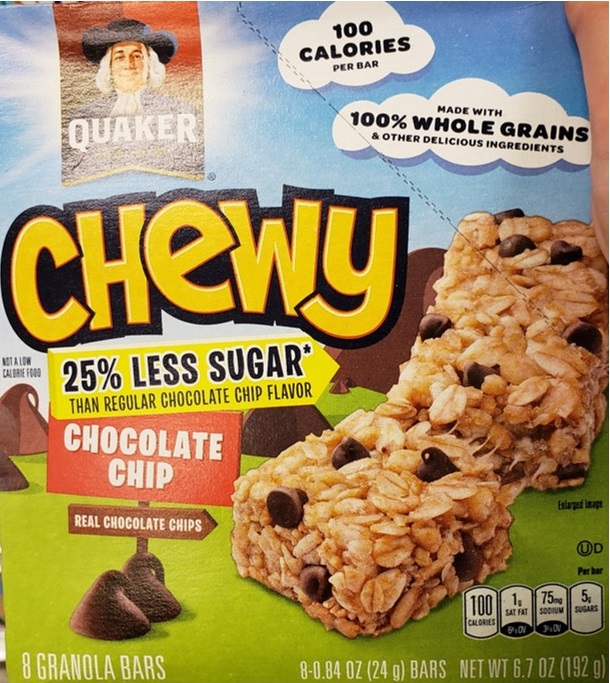
Take-home: Not all cereal bars labeled “healthy'” actually are. Be sure to check the labels!
Let’s Wrap it Up!
As parents, we’re all looking for the healthiest food options for our kids, and for ourselves. In general, it is best to avoid most overly processed foods, foods high in trans fats, and foods that are high in sugar. If you’re looking to avoid pesticides, your best bet is to wash your fruit and vegetables thoroughly to eliminate the pesticide residues on the surfaces. Pay careful attention to food labels, and in general, if something sounds too good to be true, it probably is. Happy and healthy shopping!






